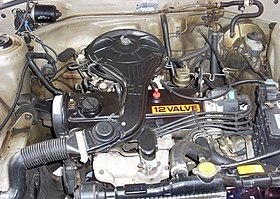
Back Toyota E-enjin AF Motor Toyota E Spanish Mesin E Toyota ID トヨタ・E型エンジン Japanese Двигатель Toyota E Russian
This article needs additional citations for verification. (July 2012) |
| Toyota E engine | |
|---|---|
 2E engine | |
| Overview | |
| Manufacturer | Toyota |
| Production | 1985–1999 |
| Layout | |
| Configuration | Straight-four |
| Cylinder block material | Cast iron |
| Cylinder head material | Aluminum |
| Valvetrain | SOHC, DOHC |
| Combustion | |
| Turbocharger | In some versions |
| Fuel system | Carbureted, Fuel injected |
| Fuel type | Gasoline |
| Cooling system | Water-cooled |
| Output | |
| Power output | 55–133 hp (41–99 kW) |
| Torque output | 72–127 lb⋅ft (98–172 N⋅m) |
| Chronology | |
| Predecessor | Toyota K engine (up to 1.3 L models) |
| Successor | Toyota SZ engine (for 1.0 L and 1.3 L models) Toyota NZ engine (for 1.3 L and 1.5 L models) |
The Toyota E engine family is a straight-four piston engine series, and uses timing belts rather than chains. The E engines were the first multi-valve engines from Toyota designed with economy, practicality and everyday use in mind (rather than performance). Like many other Toyota engines from the era, the E engine series features a cast iron block, along with an aluminium cylinder head. E engines are lighter than earlier Toyota engines, due to the hollow crankshaft, thinned casting of the cylinder block, and several other reductions in auxiliaries as well as in the engine itself. Carbureted versions include a newly designed, variable-venturi carburetor. All of these changes improved economy and emissions.[1] The members of the E engine family, range from 1.0 L to 1.5 L. The E family supplanted the K engines in most applications. A large number of parts in the E engine series are interchangeable between each other.
- ^ Tekniikan Maailma Magazine (in Finnish) (#4). 1985.
{{cite journal}}: Missing or empty|title=(help)